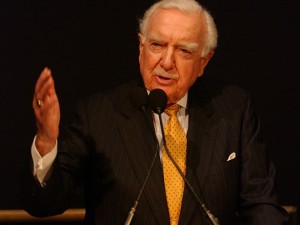 Broadcast journalists are more than interviewers and newsreaders. The great ones become part of our lives, guiding us through national traumas and celebrating with us the triumphant moments of modern history. We probably spend more time with them than with many of our relatives.
Broadcast journalists are more than interviewers and newsreaders. The great ones become part of our lives, guiding us through national traumas and celebrating with us the triumphant moments of modern history. We probably spend more time with them than with many of our relatives.
The following five individuals helped to establish the role of a broadcast journalist and to bring that position to ever-greater heights. These people are renowned for their integrity, their unflappability, and their burning desire to uncover the truth.
Edward R. Murrow
During World War II, Edward R. Murrow earned widespread acclaim for his authoritative radio reports from Europe’s front lines. After the war, he became a familiar face on television. Today, he’s probably most famous for investigating Sen. Joseph McCarthy, a politician who accused many public officials during the early 1950s of being Communists or Communist sympathizers.
Walter Cronkite
Missouri native Walter Cronkite first appeared on TV in 1950, and he anchored the “CBS Evening News” between 1962 and 1981. Many people, even those who were born long after the event, will never forget the way Cronkite removed his glasses and announced the death of John F. Kennedy. Cronkite’s career was full of iconic broadcasts, including one on the night when Americans first landed on the moon.
Mike Wallace
Mike Wallace, who died in 2012 at the age of 93, was synonymous with fearlessness. You might recall how he grilled politicians and barged into workplaces to interrogate scammers. At the start of his career, Wallace occasionally worked as an entertainer; he did some acting and hosted game shows. On ABC during the 1950s, he starred in “The Mike Wallace Interview,” a program that let him perfect his aggressive technique. Later, he spent decades with the CBS news magazine “60 Minutes,” for which he traveled the globe in search of stories.
Barbara Walters
A winner of multiple Emmy Awards, Barbara Walters has anchored NBC’s “Today” and “ABC World News Tonight.” She’s made her most significant journalistic impact, however, with editions of “The Barbara Walters Special” on ABC, the first of which aired in 1976. On these programs, Walters has spoken at length to world leaders and celebrities, and she’s mastered the art of asking penetrating and sometimes embarrassing questions while still coming across as warm and thoughtful. Fidel Castro and Richard Nixon are just two of the many notable figures who underwent such an interview.
Charles Kuralt
During the 1960s, CBS News correspondent Charles Kuralt decided to give up covering wars and politics in favor of stories about everyday American life. Thus, he began crossing the U.S. in a mobile home, and for more than two decades, he visited every part of every state. Along the way, he showcased people with odd collections, talents, and hobbies as well as the natural beauty of the continent and various historic landmarks. With his graceful prose and gift for dramatic narration, Kuralt set an extremely high standard for feature reporters.
Happily, the work of all the journalists described above lives on in the form of DVD retrospectives and online clips. Therefore, we can watch these people again and again to study the crisp, engaging ways that they present information. Certainly, the lessons that they teach will endure no matter what broadcasting formats and technologies arise in the future.
See also: The World’s 10 Most Profitable Media Companies (Infographic)
